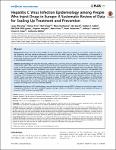Hepatitis C Virus Infection Epidemiology among People Who Inject Drugs in Europe: A Systematic Review of Data for Scaling Up Treatment and Prevention
Wiessing, Lucas
Ferri, Marica
Grady, Bart
Kantzanou, Maria
Sperle, Ida
Cullen, Katelyn J.
Hatzakis, Angelos
Prins, Maria
Vickerman, Peter
Lazarus, Jeffrey V.
Hope, Vivian D.
Matheï, Catharina
Background: People who inject drugs (PWID) are a key population affected by hepatitis C virus (HCV). Treatment options are improving and may enhance prevention; however access for PWID may be poor. The availability in the literature of information on seven main topic areas (incidence, chronicity, genotypes, HIV co-infection, diagnosis and treatment uptake, and burden of disease) to guide HCV treatment and prevention scale-up for PWID in the 27 countries of the European Union is systematically reviewed. Methods and Findings: We searched MEDLINE, EMBASE and Cochrane Library for publications between 1 January 2000 and 31 December 2012, with a search strategy of general keywords regarding viral hepatitis, substance abuse and geographic scope, as well as topic-specific keywords. Additional articles were found through structured email consultations with a large European expert network. Data availability was highly variable and important limitations existed in comparability and representativeness. Nine of 27 countries had data on HCV incidence among PWID, which was often high (2.7-66/100 person-years, median 13, Interquartile range (IQR) 8.7–28). Most common HCV genotypes were G1 and G3; however, G4 may be increasing, while the proportion of traditionally ‘difficult to treat’ genotypes (G1+G4) showed large variation (median 53, IQR 43–62). Twelve countries reported on HCV chronicity (median 72, IQR 64–81) and 22 on HIV prevalence in HCV-infected PWID (median 3.9%, IQR 0.2–28). Undiagnosed infection, assessed in five countries, was high (median 49%, IQR 38–64), while of those diagnosed, the proportion entering treatment was low (median 9.5%, IQR 3.5–15). Burden of disease, where assessed, was high and will rise in the next decade. Conclusion: Key data on HCV epidemiology, care and disease burden among PWID in Europe are sparse but suggest many undiagnosed infections and poor treatment uptake. Stronger efforts are needed to improve data availability to guide an increase in HCV treatment among PWID.
Dateien zu dieser Publikation
Keine Lizenzangabe
Verwandte Publikationen
Anzeige der Publikationen mit ähnlichem Titel, Autor, Urheber und Thema.
-
2014-04-10ZeitschriftenartikelResults of surveillance for infections with Shiga toxinproducing Escherichia coli (STEC) of serotype O104:H4 after the large outbreak in Germany, July to December 2011 Frank, Christina; Milde-Busch, Astrid; Werber, DirkAfter the massive outbreak of infections with Shiga toxin-producing Escherichia coli (STEC) of serotype O104:H4 in Germany in the summer of 2011, post-outbreak surveillance for further infections with this type of STEC was ...
-
2015-08-27ZeitschriftenartikelTransmission patterns of human enterovirus 71 to, from and among European countries, 2003 to 2013 Hassel, C.; Mirand, A.; Lukashev, A.; Terletskaia-Ladwig, E.; Farkas, A.; Schuffenecker, I.; Diedrich, Sabine; Huemer, H. P.; Archimbaud, C.; Peigue-Lafeuille, H.; Henquell, C.; Bailly, J.Enterovirus 71 (EV-71) is involved in epidemics of hand, foot, and mouth disease (HFMD) and has been reported to occur with severe neurological complications in eastern and south-east Asia. In other geographical areas, the ...
-
2015-06-24ZeitschriftenartikelEbola Virus Disease Outbreak in Isiro, Democratic Republic of the Congo, 2012: Signs and Symptoms, Management and Outcomes Kratz, Thomas; Roddy, Paul; Oloma, Antoine Tshomba; Jeffs, Benjamin; Ciruelo, Diana Pou; Rosa, Olimpia de la; Borchert, MatthiasData collected during the 2012 Ebola virus disease (EVD) epidemic in the Democratic Republic of the Congo were analysed for clinical signs, symptoms and case fatality of EVD caused by Bundibugyo virus (BDBV), establishment ...

